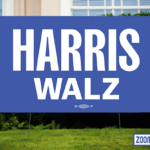1. Campaign Branding and Design
When Vice President Kamala Harris announced Minnesota Governor Tim Walz as her running mate for the 2024 election, the Harris‑Walz campaign rolled out a minimalist yet striking logo: bold white, all‑caps sans‑serif lettering on a clear background. Its simplicity echoed historical precedent (Shirley Chisholm’s 1972 campaign) and contrasted sharply with more decorative political branding. As one design critic noted, “The logo looks bold and strong… it speaks plainly and urgently.”TMJ4 News+15The Guardian+15Etsy+15That same branding extended to yard signs—typically corrugated plastic panels in sizes like 18×24″, printed on both sides and paired with an H-style metal stake for easy display. The color contrast and large lettering ensured visibility from the street to passersby, aligning with core campaign slogans like “Vote Harris Walz 2024,” “Forward,” or “We’re Not Going Back.” The simplicity amplified the message and provided instant recognition.
2. Production and Distribution
The yard signs were produced through both official channels and independent third-party sellers. On the Official Harris-Walz campaign store, signs were priced around $15–$40 depending on design and quantity, offered in multiple orientations and sizes, and described as weather-resistant and easy to set up.Harris WalzHarris WalzMeanwhile, small businesses such as The Blue Deal LLC offered union-printed, USA-made recyclable signs shipping in one to two business days, with bulk discounts bringing the price down as low as $6.99 per sign.Etsy+2The Blue Deal LLC+2Harris Walz+2Platforms like Etsy featured hundreds of customizable “Harris Walz” signs, many under $15, varying in style from traditional campaign messaging to humorous cat-themed or pop‑culture‑inspired variants.GQ+15Etsy+15Amazon+15TMJ4 News+2The Guardian+2Glamour+2
3. Cultural Impact and Merchandising
The yard sign became more than just a campaign prop; it turned into a cultural artifact. The Harris‑Walz campaign’s merchandise, including signs, shirts, and especially the viral camo hat, appealed to demographics beyond traditional political circles. The camo embroidered “Harris Walz” hat sold $1 million worth within 24 hours, admired for blending Gen X “dad style” with street‑wear aesthetics.Harris Walz+2The Guardian+2Harris Walz+2In St. Petersburg, local artist Chad Mize created “Don’t Make It Weird” yard signs with “Harris/Walz 2024,” offering a fresh, creative spin on standard campaign messaging. The signs sold for $12 each and resonated especially with left‑leaning Floridians.New York Post+15Axios+15AppleInsider+15
Photo‑worthy slogans and visually clever designs like “Childless Cat Couples for Harris and Walz” appeared in neighborhoods like Alexandria, revealing how political signage became part of community expression and identity.The Guardian+3Washingtonian+3Harris Walz+3
4. Controversies, Vandalism, and Theft
Despite or because of the sign’s visibility, they became frequent targets of theft and vandalism. Across several states, Harris‑Walz signs were stolen, spray‑painted, burned, or defaced.
- Ohio (Colerain Township): Surveillance footage captured a thief stealing multiple yard signs from supporters’ lawns late at night.NewsweekWCPO 9 Cincinnati
- Milwaukee County (Wauwatosa, Wisconsin): 15 signs across neighborhoods were vandalized with red spray paint, sparking outrage and debate about political tolerance ttps://newzpatrol.com/travelsfornow-c/ and freedom of expression.
- Pennsylvania & Massachusetts: A homeowner’s signs were vandalized a second time; others experienced signs set ablaze, prompting police investigations.WTAENewsweek
- Missouri (Springfield): One activist embedded an AirTag in her yard sign to track repeated theft; signs stolen were recovered in a trunk with dozens more stolen signs.
5. Symbolic Role in a Polarized Election Season
While some neighborhoods in swing states such as Michigan opted not to display any political signage to reduce tension, in communities where signs were common, they became markers of civic identity and collective values. One Michigan resident said many chose to display localcandidate signs only, avoiding divisive presidential signage to minimize conflict.apnews.com
In Wisconsin, while observing many Trump signs, the presence of Harris‑Walz signs was gradually increasing forming a small but visible statement of support amid difficult terrain. There, author Jake Berman described a moment of “Trail Magic” an anonymous act of kindness reminding readers that political division doesn’t define every encounter.GQ
6. Why the Yard Sign Resonated
- Visibility and grassroots appeal: A simple, affordable way for everyday citizens to publicly display political allegiance.
- Design clarity: The minimalist Harris‑Walz logo offered instant recognition and a strong aesthetic presence.
- Merch fashion: When political gear looked good and had viral potential, it connected with younger, more online demographics.
- Tension & solidarity: The risk of vandalism or theft elevated the signs’ symbolic weight—supporters often saw installation as an act of defiance or solidarity.
- Community conversation: Slogans and custom signs sparked local dialogue rather than silent partisanship.
7. Practical Details & Buying Info
If you’re considering purchasing , here’s what you’d typically find:
- Materials: 4 mm corrugated plastic (coroplast), weather- and UV-resistant, print on both sides.
- Sizes: Commonly 18×24″; some smaller 12×16″ variants.
- Setup: Metal “H-stake” included for garden or yard mounting.
- Price Range: $12–$15 per sign from official sources; bulk or custom orders as low as $6–$9 per sign from small suppliers. Custom designs or special slogans may cost more.harriswalzmerchandise.com+9Harris Walz+9Harris Walz+9The Guardian+1Glamour+1TMJ4 News+2Harris Walz+2Etsy+2Etsy
8. The Legacy of the Sign
Though the election is behind us, the leaves a legacy about modern political communication. Few campaign artifacts of prior cycles garnered such attention for style, theft stories, public defiance, and viral merch crossover. Whether it’s in museum collections, political retrospectives, or preserved yards, these signs continue to tell the story of a deeply divided yet creatively engaged electorate.It encapsulates how, during the 2024 season, a sign was not just a sign it was a message, a protest, a fashion statement, and sometimes even a legal flashpoint.
Conclusion
The represented much more than campaign support: it became a visual lens into America’s political climate, blending design, grassroots energy, divisiveness, and cultural resonance. From mainstream campaign retail to niche Etsy versions, from iconic slogans to stolen and burned signs, its journey through neighborhoods and media headlines reflected both the polarization and creative spirit of the time.Today, these yard signs stand as artifacts of the 2024 election a small rectangle of plastic bearing big stories about expression, identity, and the ongoing dynamics of American democracy.







